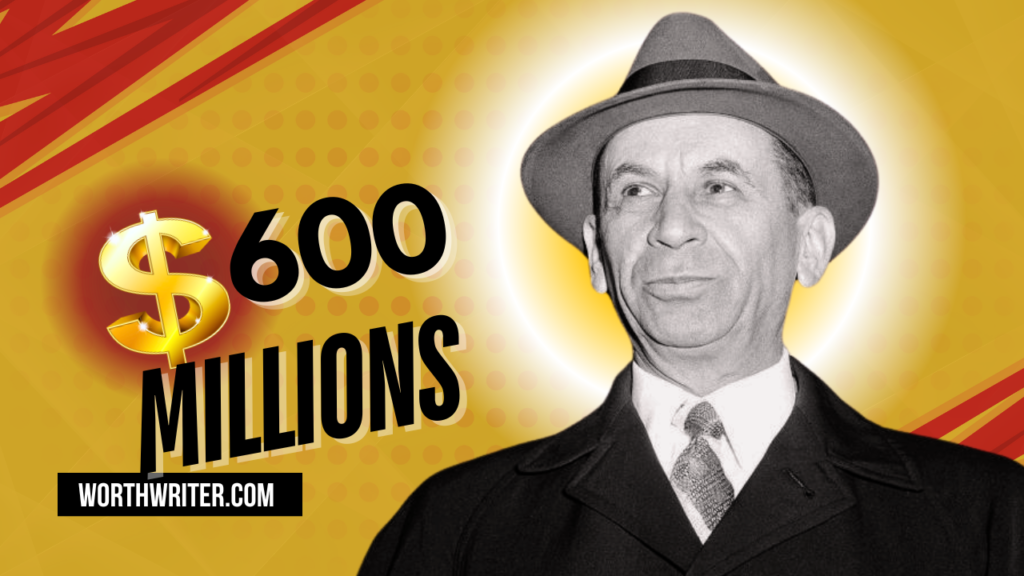Discover Meyer Lansky net worth, from his gambling empire to hidden fortunes. Explore how the ‘Mob’s Accountant’ built and concealed his wealth. Also read The Kray Twins Net Worth (2025): London’s Most Notorious.
Introduction – Meyer Lansky Net Worth
I’ve spent years studying the fascinating world of organized crime’s financial operations, and let me tell you – no one comes close to Meyer Lansky’s financial genius. Every time I dig deeper into his story, I’m amazed at how this immigrant kid from Belarus became known as the “Mob’s Accountant” and built an empire that would make modern Wall Street executives look like amateurs.
You know what’s wild? While most gangsters flashed their wealth around, Lansky played it differently. Here was a guy who claimed to die with just $35,000 to his name, yet the FBI estimated his fortune at hundreds of millions! When I was researching his story, I found myself going down a rabbit hole of hidden accounts, casino operations, and financial labyrinths that would make your head spin.
Let me break down the essential facts about Meyer Lansky’s wealth before we dive deeper:
| Quick Reference | Details |
| Birth Name | Meier Suchowlański |
| Peak Net Worth (2025 Value) | $600 million |
| FBI Estimated Hidden Assets | $300-400 million |
| Declared Assets at Death | $35,000 |
| Primary Enterprise | Gambling Operations & Financial Management |
| Major Operations | Florida, Cuba, Las Vegas |
| Years Active | 1920s-1970s |
In this article, we’ll unravel the complex web of Lansky’s financial empire, from his early days running bootlegging operations with Bugsy Siegel to his sophisticated international casino network. I’ll share insights into how he managed to build and hide one of the largest criminal fortunes in history, and why most of it remains unaccounted for even today.
Stay with me as we follow the money trail of America’s most enigmatic financial criminal mastermind. Trust me – this story has more twists than a casino’s account books during a Friday night audit!
What Was Meyer Lansky’s Actual Net Worth?
| Source | Estimated Net Worth | Context |
| 2025 Adjusted Value | $600 million | Total estimated wealth adjusted for inflation |
| FBI Records | $300-400 million | Hidden in international bank accounts |
| Official Declaration | $35,000 | Declared assets at time of death (1983) |
Meyer Lansky’s true net worth remains one of organized crime’s most intriguing financial mysteries. While official records at his death in 1983 showed only $35,000 in declared assets, FBI investigations estimated he had between $300-400 million hidden in various international bank accounts. When adjusted for inflation in 2025, his total wealth could have reached approximately $600 million. This stark contrast between his declared assets and estimated wealth demonstrates Lansky’s exceptional ability to conceal his fortune through sophisticated financial networks spanning multiple continents.
Key Facts About Lansky’s Wealth:
- Peak of wealth came from Cuban casino operations in the 1950s
- Extensive network of offshore accounts and shell companies
- Never successfully prosecuted for major financial crimes
- Majority of his fortune remains undiscovered
- Developed innovative money laundering techniques still studied today
The Building Blocks of Lansky’s Fortune
You know what amazes me most about Meyer Lansky’s story? It’s not just the numbers – it’s how he built his empire from literally nothing. When I researched his rise to power, I discovered a fascinating pattern of strategic business moves that would impress any Fortune 500 CEO.
Let me break down how Lansky built his fortune through various ventures:
| Time Period | Business Venture | Estimated Revenue Impact |
| 1920s | Prohibition Bootlegging | Initial capital building |
| 1930s | Gambling Operations Expansion | Major profit center establishment |
| 1940s-1950s | Cuban Casino Empire | Peak wealth generation |
| 1960s-1970s | International Banking Operations | Wealth preservation phase |
It all started during Prohibition with the Bugs and Meyer Mob. Unlike other gangsters who saw bootlegging as just quick cash, Lansky viewed it as a business school. He learned about supply chains, distribution networks, and most importantly, how to launder money through legitimate businesses. This foundation would prove crucial for his later ventures.
The real genius came in the 1930s when he started expanding into gambling. Lansky understood something fundamental – gambling wasn’t just about the house always winning; it was about creating a legitimate-looking business structure that could handle massive cash flows. He established operations in Florida, partnering with local officials and legitimate businessmen, creating a model that he would later perfect in Cuba and Las Vegas.
Speaking of partnerships, Lansky’s collaboration with Bugsy Siegel in developing Las Vegas showed his talent for long-term investment thinking. While others saw desert wasteland, Lansky envisioned a legitimate gambling paradise. The Flamingo Hotel, despite its troubled beginnings, helped establish the blueprint for modern Las Vegas casinos.
But here’s what really set Lansky apart – his understanding of diversification. He didn’t just stick to one type of operation. He spread his investments across:
- Legal casinos and hotels
- Real estate developments
- Transportation companies
- Import/export businesses
- Restaurant chains
- Vending machine operations
Each business served two purposes: generating legitimate income and providing a channel for laundering illegal profits. It was this dual-purpose approach that made tracking his actual wealth so challenging for authorities.
Would you believe that during World War II, he even worked with the U.S. Navy to protect New York’s ports from Nazi saboteurs? This kind of strategic thinking and ability to work with legitimate authorities while maintaining his criminal empire showcases why he was nicknamed the “Mob’s Accountant.“
Hidden Wealth: Lansky’s Financial Mastery
When I look at modern money laundering cases, I can’t help but notice how many techniques trace back to Lansky’s innovations. His financial genius wasn’t just about making money – it was about making it disappear and reappear as legitimate wealth.
| Financial Method | Purpose | Innovation |
| Casino Skimming | Untraceable Cash Extraction | Pre-reporting profit removal |
| Shell Companies | Asset Concealment | Multi-layered ownership structures |
| Swiss Banking | Wealth Protection | Numbered account system |
| Real Estate Investment | Money Laundering | Legitimate business fronts |
Lansky pioneered what we now call “layering” in money laundering. He created such complex networks of businesses and accounts that even today, forensic accountants study his methods. His favorite technique? The “loan-back” scheme, where dirty money would leave the country through one channel and return as a legitimate loan from a foreign bank.
The casino operations were particularly brilliant. Lansky invented the concept of “skimming” – removing money before it was counted as official revenue. In Cuba’s Havana Riviera casino alone, it’s estimated that up to 30% of daily revenues disappeared this way. That’s millions vanishing without a trace!
Swiss banks became his partners in wealth concealment. But here’s the clever part – he didn’t just use Swiss accounts. He created a global network of accounts, moving money through multiple countries to obscure its origin. Panama, Liechtenstein, and the Bahamas all played roles in his financial web.
What really impresses me is his understanding of legitimate business structures. He would buy controlling interests in legal businesses through such complicated chains of ownership that proving his connection became nearly impossible. One FBI agent famously said tracking Lansky’s money was like “trying to follow footprints in water.”
The Cuban Connection: Peak of Wealth and Loss
The Cuban years were Lansky’s golden age – and ultimately, his biggest setback. Let me paint you a picture of just how massive his Cuban operation was.
| Cuban Property | Estimated Value (1950s) | Annual Revenue |
| Habana Riviera | $14 million | $3-4 million |
| Hotel Nacional Casino | $10 million | $2-3 million |
| Other Casino Interests | $30+ million | $8-10 million |
In pre-Castro Cuba, Lansky had turned Havana into his personal Las Vegas. The Habana Riviera was his crown jewel – a $14 million investment that became the largest casino-hotel in Latin America. But it wasn’t just about the Riviera. He had interests in nearly every major casino in Havana, creating a gambling empire that generated millions in annual revenue.
What made Cuba perfect was its combination of proximity to the U.S., lax banking regulations, and corrupt government officials willing to look the other way. Lansky even had his own suite at the Hotel Nacional, where he would host politicians and celebrities, building relationships that protected his interests.
But then came the Cuban Revolution in 1959. Castro’s rise to power meant the overnight loss of Lansky’s entire Cuban empire. The hotels and casinos were seized, and decades of careful building crumbled. This wasn’t just a financial loss – it was a strategic catastrophe that forced him to rebuild his network from scratch.
Legal Battles and Asset Protection
The story of Lansky’s legal battles reads like a financial thriller. Unlike other mobsters who often faced violent crime charges, Lansky’s biggest enemy was the IRS. Let me share how he managed to outmaneuver some of the best financial investigators in the world.
| Year | Legal Challenge | Outcome |
| 1970 | Tax Evasion Charges | Fled to Israel |
| 1971 | Israeli Citizenship Denial | Deportation to US |
| 1973 | Grand Jury Investigation | No Indictment |
| 1974 | Tax Evasion Trial | Acquitted |
The 1970 tax evasion case was perhaps his biggest challenge. With the IRS closing in, Lansky made a bold move – he fled to Israel, attempting to claim citizenship under the Law of Return. His strategy was brilliant: Israel’s banking laws would have made it nearly impossible for U.S. authorities to track his assets.
But here’s where it gets interesting. The Israeli government, under pressure from the U.S., denied his citizenship request. After two years of legal battles, he was forced to return to America. Yet even this setback showcased Lansky’s financial genius – during those two years, he had managed to move and restructure his assets so effectively that prosecutors struggled to build their case.
Back in the U.S., Lansky faced multiple investigations and trials. The government’s frustration was palpable – they knew he had millions, but proving it was another matter. His defense strategy was remarkable: he claimed near poverty, living in a modest Miami Beach apartment and maintaining a simple lifestyle that seemed to contradict the FBI’s claims of hidden wealth.
The Legacy of the Mob’s Financial Genius
Today, Lansky’s influence extends far beyond his time. His financial innovations – both legal and illegal – have left an indelible mark on how we understand money laundering and financial crime.
| Innovation | Modern Impact |
| Shell Company Networks | Standard practice in offshore finance |
| Casino Management | Modern gaming industry standards |
| International Banking | Global money movement techniques |
| Business Integration | Modern corporate structuring |
His methods for concealing wealth have become textbook examples studied by both law enforcement and financial institutions. The concept of layering transactions through multiple jurisdictions, which Lansky perfected, is now a fundamental principle in anti-money laundering regulations.
Perhaps most fascinating is how many of his legitimate business practices were ahead of their time. His understanding of international banking relationships, corporate structures, and the importance of diversification would fit right in with modern multinational corporations.
The missing millions continue to intrigue investigators and researchers. Even today, there are occasional claims of Lansky’s money being discovered in forgotten accounts or hidden investments. This ongoing mystery only adds to his legend as the greatest financial mind in organized crime history.
The truth is, Lansky’s greatest achievement wasn’t just accumulating wealth – it was creating a financial system so complex that even decades after his death, we’re still discovering its intricacies. His story serves as both a cautionary tale about financial crime and a testament to the importance of understanding complex money flows in our modern economy.
Conclusion: The Eternal Mystery of Meyer Lansky’s Fortune
When I look back at Meyer Lansky’s financial legacy, I’m struck by the stark contrast between his modest public persona and the vast empire he built. His story isn’t just about the money – it’s about the creation of a financial labyrinth that continues to baffle experts decades after his death.
The numbers tell part of the story: a declared $35,000 at death versus the FBI’s estimate of $300-400 million (worth approximately $600 million in 2025). But the real legacy lies in how he fundamentally changed the way we think about money movement and financial concealment.
Key Takeaways:
- Lansky’s financial innovations revolutionized both criminal enterprises and legitimate banking practices
- His Cuban casino empire represented the peak of his wealth before its devastating loss
- Despite numerous investigations, most of his fortune remains unaccounted for
- His methods continue to influence modern financial systems and regulations
Perhaps most intriguing is that somewhere in the world, pieces of Lansky’s fortune might still exist in dormant accounts or hidden investments. While we may never know the true extent of his wealth, his impact on financial history is undeniable.
For anyone interested in the intersection of finance and crime, Meyer Lansky’s story serves as a masterclass in financial innovation – albeit one that operated in the shadows. His life reminds us that sometimes the greatest wealth lies not in what we can see, but in what remains hidden.
[Call to Action] Want to learn more about historic financial figures and their impact on modern banking? Subscribe to our newsletter for weekly deep dives into fascinating stories from financial history. [Author’s Note] This article is part of our series on influential financial figures of the 20th century. While we strive for accuracy, some details about Meyer Lansky’s wealth remain disputed by historians and investigators.Frequently Asked Questions
How did Meyer Lansky hide his money?
Lansky employed several sophisticated methods to conceal his wealth:
International Banking Network
Created accounts across multiple countries
Used numbered Swiss bank accounts
Established relationships with private bankers
Utilized bearer bonds and certificates
Shell Company Structure
Created multiple layers of corporations
Used nominee directors and shareholders
Established businesses in tax havens
Mixed legitimate and illegitimate funds
Casino Operations
Developed skimming techniques
Used cash-intensive businesses
Created false documentation
Maintained dual bookkeeping systems
What happened to Meyer Lansky’s fortune after his death?
After Meyer Lansky’s death in 1983, most of his fortune remained hidden and unrecovered. While he officially died with only $35,000 in his bank account, the FBI estimated his hidden wealth at $300-400 million. Despite extensive investigations, the majority of his assets were never located. Some financial experts believe his money remains in dormant accounts, while others suggest he transferred the wealth to family members through complex legal structures before his death. The mystery of Lansky’s missing millions continues to intrigue investigators and historians today.
Was Meyer Lansky ever convicted of tax evasion?
No, Meyer Lansky was never convicted of tax evasion. In 1970, he fled to Israel when faced with tax evasion charges but was deported back to the United States in 1972. He stood trial in 1974 and was ultimately acquitted of all charges. His successful defense strategy involved claiming near-poverty and maintaining a modest lifestyle that contradicted the government’s claims of vast hidden wealth. Throughout his career, despite numerous investigations, Lansky was never convicted of any serious financial crimes, leading many to consider him one of the most successful financial criminals in history.
How did Lansky influence modern banking practices?
Meyer Lansky’s financial innovations significantly influenced modern banking practices, particularly in international finance. He pioneered techniques like layered transactions, offshore banking networks, and complex corporate structures that are now standard in global finance. While his methods were used for illegal purposes, many of his innovations in international money movement and corporate structuring have been adapted for legitimate business purposes. His understanding of international banking relationships and the importance of financial privacy helped shape modern banking secrecy laws and anti-money laundering regulations.



